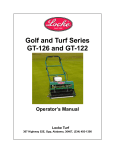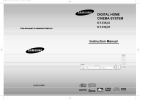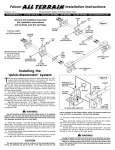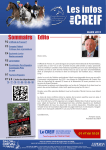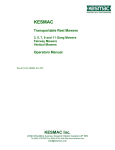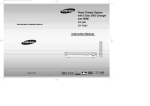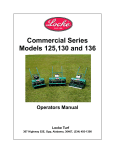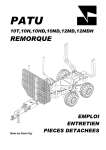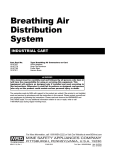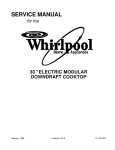Download Locke TRM-3083 User's Manual
Transcript
Reel Mower TRM-3083, TRM-5138 TRM-7192 Operators Manual Locke Turf 307 Highway 52E, Opp, Alabama, 36467, (334) 493-1300 CONGRATULATIONS You have invested in the best implement of its type on the market today. The care you give your Locke Turf implement will greatly determine your satisfaction with its performance and its service life. We urge a careful study of this manual to provide you with a thorough understanding of you new implement before operating, as well as suggestions for operation and maintenance. If your manual should become lost or destroyed, Locke Turf will be glad to provide you with a new copy. Order from Locke Turf, 307 Highway 52E, Opp, Alabama 36467. As and Authorized Locke Turf dealer, we stock genuine Locke Turf parts which are manufactured with the same precision and skill as our original equipment. Our trained service personnel are well informed on methods required to service Locke Turf equipment, and are ready and able to help you. Should you require additional information or assistance, please contact us. YOUR AUTHORIZED LOCKE TURF DEALER BECAUSE LOCKE TURF MAINTAINS AN ONGOING PROGRAM OF PRODUCT IMPROVEMENT, WE RESERVE THE RIGHT TO MAKE IMPROVEMENTS IN DESIGN OR CHANGES IN SPECIFICATIONS WITHOUT INCURRING ANY OBLIGATION TO INSTALL THEM ON UNITS PREVIOUSLY SOLD. BECAUSE OF THE POSSIBILITY THAT SOME PHOTOGRAPHS IN THIS MANUAL WERE TAKEN OF PROTOTYPE MODELS, PRODUCTION MODELS MAY VARY IN SOME DETAIL. IN ADDITION, SOME PHOTOGRAPHS MAY SHOW SHIELDS REMOVED FOR PUR POSES OF CLARITY. NEVER OPERATE THIS IMPLEMENT WITHOUT ALL SHIELDS IN PLACE. REEL MOWER Operator’s Manual Table of Contents SECTION Introduction …………………...…………2,3 Federal Laws and Regulations ………….4 Dealer Preparation Check List…………..5 Federal Laws and Regulations…………..7 Safety...………………………...……...…..7 Operation..…………………………………7 Hook Up……………………………………7 Leveling the Frame……...……………..…7 Tractor Hook-Up………….……………….8 Belt Idlers……………………………….….8 Lift Chain Adjustment.…………………...8 Mowing Unit Belt Adjustment.....………..8 Mowing…….………………..……………..9 Reel Adjustment.......………….………....9 Mowing Height Adjustment..…………...10 Hydraulic Lift Operation…….………..…11 Mowing w/ V-Reel……………………….12 Trouble Shooting………………………..15 Maintenance….……………………..…..16 Component Location Diagrams……….17 Safety Decals…………………………...18 Torque Specifications………….……….21 RETAIL CUSTOMER’S RESPONSIBILITY UNDER THE LOCKE TURF INC. WARRANTY It is the Retail Customer and /or Operator’s responsibility to read the Operator’s Manual, to operate, lubricate, maintain, and store the product in accordance with all instructions and safety procedures. Failure of the operator to read the Operator’s Manual is a misuse of this equipment. It is the Retail Customer and/or Operator’s responsibility to inspect the product and to have any part(s) repaired or replaced when continued operation would cause damage or excessive wear to other parts or cause a safety hazard. It is the Retail Customer’s responsibility to deliver the product to the authorized Locke Turf distributor from whom he purchased it, for service or replacement of defective parts that are covered by warranty. Repairs to be submitted for warranty consideration must be made within fort-five (45) days of failure. It is the Retail Customer’s responsibility for any cost incurred by the Dealer for traveling to or hauling of the product for the purpose of performing a warranty obligation or inspection. UNDERSTAND SIGNAL WORDS DANGER: Indicates an imminently Hazardous situation which, if not avoidEd, will result in death or serious injury. This signal word is to be limited to the Most extreme situations. WARNING: Indicates a potentially hazardous situation which, if not Avoided, could result in death or serious injury. CAUTION: Indicates a potentially hazardous situation which, if not avoided, may result in minor or Moderate injury. It may also be Used to alert against unsafe INTRODUCTION More than merely devices created for mowing grass, the excellence of design, construction and operation of Locke power mowers is unparalleled. Introduced in 1928, tested and proven, Locke power mowers may be considered, in terms of today’s technology, the ultimate response to the need for the highest degree of quality lawn care. These magnificent green machines are legendary and known throughout the world for generation-spanning durability and unequalled performance in the precision cutting of grass. Locke power mowers are heavy-duty, precision instruments. No capricious model year or cosmetic style changes are instituted, although improvements are continually incorporated into all models. The most recent evidence this is in the introduction of the new “Commercial Series”. Design and manufacturing innovations make this the mower for the next century. Whatever model of Locke power mower you have purchased you have our assurance that, with proper care, you are the owner of a machine which will provide many years of dependable service. To extract the fullest possible value from the performance of your Locke power mower we urge you to read this manual very carefully. Should you find any of the instructions unclear, please contact your Locke dealer or call the Locke Factory Service Department. Phone: 334-493-1300 Fax: 334-493-1400 Locke Mowers: The Finest Cut….For The Finest Lawns 2 INTRODUCTION Locke Turf welcomes you to the growing family of new product owners. This implement has been designed with care and built by skilled workers using quality materials. Proper assembly, maintenance and safe operating practices will help you get years of satisfactory use from the machine. Definitions: NOTE: A special point of information related to its preceding topic. The author’s intention is that you read and note this information before continuing. IMPORTANT: Information, related to its preceding topic, that the author feels would be of use. Description of Unit The TRM Model Reel Mowers are precision finishing implements. The placement and rotation of the cutting blades are installed to ensure the maximum “cut” without damaging the turf. The Reel Mower is driven at a rate slower than PTO shaft to obtain maximum cut. Owner Assistance If customer service or repair parts are required contact your local Locke Turf dealer. They have trained personnel, repair parts and the equipment needed to service your implement. These parts have been specially designed and should only be replaced with genuine Locke Turf parts. Features Include: • Drive ratio is factory preset to assure optimum cutting. • Standard rear rollers and optional front rollers are mounted to maintain constant mowing height. • Easy access for maintenance. • Integral style hitch to implement prevents skewing on hillsides. • Shields in place to prevent buildup. • Mowing large areas of turf year after year with low maintenance. Serial Number Plate – Refer to Figure below for the location of your serial number plate. Serial Number Plate Location Intended Usage This machine is intended to be used primarily for precision mowing of large areas of turf. Using This Manual The Operator’s Manual is designed to help familiarize you with safety, assembly, operation, adjustments, troubleshooting and maintenance. Read this manual and follow the recommendations to help ensure safe and efficient operation. The information contained within this manual was current at the time of printing. Some parts may change slightly to assure you of the best performance. Terminology “Right” or “Left” as used in this manual is determined by facing the direction the machine will travel while in use unless otherwise stated. For prompt service always use the serial number and model number when ordering parts from your Locke Turf dealer. Be sure to include your serial number and model number in correspondence also. Your dealer wants you to be satisfied with your new machine. If for any reason you are not satisfied with the service received, the following actions are suggested: 1. First, discuss the matter with your dealership service manager. Make sure they are aware of any problems you may have had and that they have had the opportunity to assist you. 2. If you are still not satisfied, seek out the owner or General Manager of the dealership and explain the problem and request assistance. 3. For further assistance beyond that provided by your dealer, you may contact: Locke Turf – Customer Service 307 Highway 52E Opp, Alabama 36467 3 DEALER PREPARATION CHECK LIST REEL MOWER BEFORE DELIVERING MACHINE- The following check list should be completed. Use the Operator’s Manual as a guide. 1. Assembly completed. 2. Gearbox filled with oil. 3. All fittings lubricated. 4. All shields in place and in good condition. 5. All fasteners torqued to specifications given in Torque Chart. 6. All decals in place and readable. (See decal page.) 7. Overall condition good (i.e. paint, welds) 8. Operators manual has been delivered to owner and he has been instructed on the safe and proper use of the mower. Dealer’s Signature______________________________________________________ Purchaser’s Signature___________________________________________________ THIS CHECKLIST IS TO REMAIN IN OWNER’S MANUAL It is the responsibility of the dealer to complete the procedures listed above before delivery of this implement to the customer. 4 IMPORTANT FEDERAL LAWS AND REGULATIONS* CONCERNING EMPLOYERS, EMPLOYEES AND OPERATIONS. *(This section is intended to explain in broad terms the concept and effect of the following federal laws and regulations. It is not intended as a legal interpretation of the laws and should not be considered as such.) U.S. Public Law 91-596 (The Williams-Steiger Occupational and Health Act of 1970) OSHA This Act Seeks: “…to assure so far as possible every working man and woman in the nation safe and healthful working conditions and to preserve our human resources…” DUTIES Sec. 5 (a) Each employer(1) shall furnish to each of his employees employment and a place of employment which are free from recognized hazard that are causing or are likely to cause death or serious physical harm to his employees; (2) shall comply with occupational safety and health standards promulgated under this Act. a. Each employee shall comply with occupational safety and health standards and all rules, regulations and orders issued pursuant to this Act which are applicable to his own actions and conduct. OSHA Regulations Current OSHA regulations state in part: “At the time of initial assignment and at least annually thereafter, the employer shall instruct every employee in the safe operation and servicing of all equipment with which the employee is or will be involved.” These will include (but are not limited to) instructions to: Keep all guards in place when the machine is in operations: Permit no riders on equipment; Stop engine, disconnect the power source and wait for all machine movement to stop before servicing, adjusting, cleaning or unclogging the equipment, except where the machine must be running to be properly serviced or maintained, in which case the employer shall instruct employees as to all steps and procedures which are necessary to safely service or maintain the equipment. Make sure everyone is clear of machinery before starting the engine, engaging power or operating the machine. EMPLOYEE TRACTOR OPERATING INSTRUCTIONS: 1. Securely fasten your seat belt if the tractor has a ROPS 5. Watch where you are going especially at row ends, on roads and around trees. 2. Where possible avoid operating the tractor near Ditches, embankments and holes. 6. Do not permit others to ride. 7. Operate the tractor smoothly – jerky turns starts or stops 3. Reduce speed when turning, crossing slopes and on rough, slick or muddy surfaces . 4. Stay off slopes too steep for safe operation . 8. Hitch only to the drawbar and hitch points recommended by tractor manufacturers 9. When tractor is stopped, set brake securely and use park lock if available Child Labor Under 16 Years Old Some regulations specify that no one under the age of 16 (sixteen) may operate power machinery. It is your responsibility to know what these regulations are in you own area or situation. (Refer to U.S. Dept, of Labor, Employment Standard Administration, Wage & Home Division, Child Labor Bulletin #102.) 5 SECTION 1 – SAFETY IMPORTANT SAFETY INFORMATION This Safety Alert Symbol means: ATTENTION! BECOME ALERT! YOUR SAFETY IS INVOLVED! The Safety Alert Symbol identifies important safety messages in manuals and on equipment safety signs. To avoid possible injury or death, follow the equipment and manual’s safety instructions. In addition to the design and configuration of equipment, hazard control and accident prevention are dependent upon the awareness, concern, prudence and proper training of personnel in the operation, transport, maintenance and storage of equipment. Read the operator’s manual for your safety and understanding of the equipment. Store the manuals in a safe and accessible location for your future reference. Safety Rules Following the safety practices in the operator’s manuals and equipment safety signs will help minimize accident possibility and increase equipment productivity. MAKE SURE EVERYONE THAT WILL USE THIS MACHINE HAS READ OR HAD THE OPERATOR’S MANUAL AND EQUIPMENT SAFETY SIGNS INFORMATION EXPLAINED AND UNDERSTANDS HOW TO OPERATE IT SAFELY. General The safe operation of any machinery is a big concern to users and manufacturers. Your Verti-Cutter has been designed with many built-in safety features. However, no one should operate this machine before carefully reading the Operator’s Manual. 1. 2. 3. 4. 5. 6. 7. and tighten if necessary. 8. Travel slowly over rough terrain and be alert to holes and gullies 9. When traveling on public roads, use accessory lights and devices for adequate warning to operators of other vehicles. Comply with all Federal, State and Local laws. 10. Never operate the Reel Mower while in the raised transport position. 11. Be alert to traffic when crossing or cutting near roadways. 12. Disengage the tractors’ PTO when raised transport. 13. Wear proper eye protection to prevent injury from flying objects. 14. Keep PTO shielding in place and in good condition. Do not operate mower with shields missing. 15. Always use proper PTO speed or machine damage may result. This mower is designed to be used with a tractor using a 540 rpm rear PTO. Important: never should a tractor equipped with a 1000 rpm PTO operate a machine equipped for 540 rpm PTO. 16. In order to maintain steering control add ballast to tractor. To determine the amount of ballast required refer to your tractor operator’s manual. 17. Before performing maintenance, disconnect PTO driveline and hydraulic hoses and make sure the transport locks are installed on the wing decks and center deck. 18. Transport mower with transport chain in place. 19. Escaping hydraulic fluid under pressure can have sufficient force to penetrate the skin. Check all hydraulic hoses before applying pressure. Fluid escaping from a very small hole can be almost invisible. Use a piece of cardboard, not body parts, to check for suspected leaks. If injured, seek medical assistance from a doctor that is familiar with this type of injury. Foreign fluids in the tissue must be surgically removed within a few hours or gangrene will result. 20. Do not permit anyone to stand between tractor and mower – especially during tractor hook-up. 21. Stand clear of mower when raising or lowering. Prior To Operation 1. Do not allow anyone to operate this machine that has not been properly trained in its safe 2. operation. Do not let children operate the implement. 3. Never allow passengers. Never operate the mower near people; and maintain as much distance from the rear of the mower and any people as possible. Before mowing, clear the area of objects and debris that could become entangled in the blades or thrown from the mower. After striking an object, disengage PTO, shut off tractor and inspect for damage before continuing. Do not operate the cutter in reverse unless necessary. Check periodically for loose hardware 6 Do not stand between tractor and implement during hitching. Do not operate without safety chain properly attached to tractor. Make sure hydraulic lines are attached to correct ports. CAUTION SOME ILLUSTRATIONS MAY SHOW SHIELDS OR COVER PANELS REMOVED FOR CLARITY. NEVER OPERATE UNIT WITHOUT ALL SHIELDS AND COVER PANELS IN PLACE. During Operation 1. Tractor should be equipped with ROPS and seat belt during operation. 2. Do not allow anyone to operate this machine who has not been properly trained in its safe operation. 3. Do not allow children to operate the implement. 4. Never dismount from a moving tractor. 5. Put tractor in park, turn off engine, remove key and allow moving parts to stop before making any adjustment to the implement. 6. Do not leave the tractor or the implement with the engine running. 7. Never allow passengers. 8. Travel slowly over rough terrain and be alert to holes and gullies. 9. Loose fitting clothing should not be worn as it may catch in moving parts. 10. If a hydraulic leak develops, correct it immediately. Escaping hydraulic oil can have extremely high pressure. A stream if highpressure oil may easily penetrate the skin as with modern needle less vaccination equipment, but with the exception that hydraulic fluid may cause blood poisoning. It is imperative that the connections are tight and that all lines and pipes are in good condition. If the escaping hydraulic fluid causes an injury, see a doctor at once! Use a piece of cardboard or wood to detect leaks of hydraulic oil under pressure. Be sure to relieve all hydraulic pressure before disconnecting any lines or pipes between the implement and the tractor hydraulic system. Keep all guards and shields in place. 11. Do not turn tractor in too tight; implement may ride up on wheels causing machine and bodily damage. WARNING CONTACT WITH OVERHEAD POWER LINES CAN CAUSE SEVERE ELECTRICAL BURNS OR DEATH FROM ELECTROCUTION. MAKE SURE THERE IS ENOUGH CLEARANCE BETWEEN COMPONENTS AND OVERHEAD POWER LINES. DO NOT LOAD NEAR POWER LINES. DO NOT CLIMB NEAR POWER LINES. WARNING THIS MACHINERY CAN BE VERY DANGEROUS AND CAN CAUSE SEVERE INJURY OR DEATH BY ENTANGLEMENT. READ AND UNDERSTAND MANUAL BEFORE ATTEMPTING TO OPERATE IT. After Operation 1. Detach and store implement in an area where children normally do not play. Stabilize implement by using suitable supports and block wheels. Be alert to traffic when crossing or operating near roadways. Always maintain complete control of the machine. Know your state and local laws concerning highway safety and regulations. Comply with these laws when transporting machinery. Limit transport speed to 20 mph. Transport only with an appropriate vehicle of sufficient size and horsepower. Refer to Attaching Reel Mower to the tractor under the “Operating Instructions” section. 2. 3. During Maintenance 1. 2. 3. 4. 5. 6. Securely block up implement before doing any work underneath it. Tire changing can be dangerous and should be performed by trained personnel using the correct tools and equipment. Do not re-inflate a tire that has been run flat or seriously under inflated. Have it checked by qualified personnel. When removing and installing wheels, use wheel handling equipment adequate for the weight involved. Before greasing and oiling implement, shift tractor into park, disengage PTO, turn off engine, remove key and allow moving parts to stop. After repairing or adjusting, make sure all tools and parts are removed from the implement before attempting to operate it. NOTE DURING BACKLAPPING OR SHARPENING, CAREFULLY FOLLOW THE INSTUCTIONS THAT ARE FURNISHED WITH THE SHARPENING EQUIPMENT. 7 Hook Up 1. Engage Clevis swivel hitch or ball hitch to tractor drawbar using draw bar pin or ball supplied. IMPORTANT For correct leveling, adjust Reel Mower unit tongue height so that the front and rear jackshafts are equal distances above ground level. Leveling the Frame – Tongue Adjustments The bolt on section of the tongue can be rotated to three different positions. The clevis can be rotated two different ways. This provides 6 different heights for leveling the frame. (See diagram below) 2. Adjust the mower’s hitch to the tractor’s drawbar height. Keep frame level, with tractor and mower on level ground. Place framing level across the square frame segments front to rear and adjust hitch height to level the frame. 3. Attach the mower with a 3/4" hitch pin and secure it with a lock pin. Always use a pin that contains a safety locking device to prevent it form falling out. 4. Lower the tongue jack until the weight of the mower is fully removed from the jack, then remove the jack. Store the jack on the left hand frame rail. A storage base is located on top of the frame tube. 5. Attach the safety chain on the frame hitch to the tractor. Adjust the chain length to remove all slack except what is necessary to permit turning of the mower. Lock the hook securely on the chain. 6. The driveline from the tractor is one with a constant velocity. Always attach the end with the constant velocity to the tractor’s PTO shaft. Attach the other end to the splined jackshaft on the center of the transport frame. 7. Move the driveline back and forth to insure that it is secured on the PTO shaft of the tractor and power divider input shaft on the mower. 8. Secure the chain on the driveling around mower frame to restrict the outer shield of the driveline from rotating. NOTE: A chain is supplied with each driveline. This chain must be attached to the shield cone of each driveline and to an anchor ring on the cutter hitch. NOTE: The use of a drawbar hung between the 3point hitch arms is not recommended; a straight drawbar attached to the rear axle housing in the standard SAE position to the PTO is preferable. Tractor Hook-Up 1. Back the tractor up close to the hitch. Raise or lower, with the hitch tongue jack, in order to level the mower’s frame. 9. Should the driveline shaft require shortening: a. Hold the half shafts next to each other in the shortest working position and mark them. b. Shorten inner and outer guard tubes equally. c. Shorten inner and outer sliding profiles by the same length as the guard tubes. d. Proper overlap is a minimum of one-half the length of each tube, with both tubes being of equal length. e. Round off all sharp edges and remove burrs. Grease sliding profiles. 10. Route the cylinder hoses through the hose support and connect to tractor remote outlets. Refer to “ Hydraulic Plumbing” on page 9 for proper hook-up. Quick disconnect hydraulic fittings for your tractor are available from your dealer. Hydraulic Hook-up Insert the hydraulic hose quick-disconnect plugs into the female quick-disconnects on the tractor external hydraulics. The large (constant velocity U-joint) end of the shaft goes on the tractor’s PTO shaft. Mower 3. 4. Tractor PTO Shaft Tighten the inner adjusting nut until all the slack is taken out of the chain. Tighten the outer adjusting nut. Mowing Unit Drive Belt Replacement To replace mowing unit drive belt: 1. 2. NOTE: Refer to page 16 for locations of components. 3. Belt Idlers – Main Drive 4. Check regularly for correct belt tension, particularly every 5 to 10 hours following installation of new belts. To adjust belt idlers: 1. Remove belt guards. 2. Loosen idler clamping bolt. 3. Adjust idler to allow 3/4" to 1” up and down movement of the bolt half way between sheaves. 4. Replace bolt guards. TELESCOPING ARM IS HEAVILY SPRUNG; EXTREME CARE MUST BE TAKEN TO AVOID PERSONAL INJURY. 5. Lift Chain Adjustment - Units #4 & #5 6. The outer lift chains on mowing units #4 and #5 provide adjustment of the nylon rollers in the snubbers and lift operation. IF the #4 and #5 mowing units do not engage the snubber ramps properly when lifting, adjust as follows: 1. Lower cutting units to the ground and loosen the nut on the chain-adjusting rod and back off the nut several turns. 2. Remove the clevis pin form the adjusting yoke. 3. Turn the adjusting yoke towards the nut to increase the lift and decrease the roller clearance in the snubber. 4. Replace the yoke and clevis pin, making sure that the chain is not twisted. 5. Lift the mowing units into place to check that adjustment is correct when there is slight tension on the lift chain and the nylon rollers are tight in the snubber. 6. When adjustment is correct, tighten the adjusting rod locking nut. Insure also that the cotter pin is secure. 7. 8. 9. 10. 11. 12. 13. 14. The inner chains on mowing units #6 and #7 allow adjustment for even lift. If the outer mowing units lift unevenly, they may be adjusted as follows: 2. Remove small bolt on upper flange of V-belt guard. Remove 3/4” bolt from telescoping arm end and guard. To remove belt from center mowing units it is necessary to remove the coupling and pull the belt through the gap between the jackshafts. Place the new belt around the jackshaft pulley, making sure that it goes to the right of a right hand telescoping arm or to the left of a left hand telescoping arm. Replace the 3/4” bolt through the guard, telescoping arm and frame. Replace the small bolt through the upper flange of the guard. Replace the jackshaft coupling (if removed). Compress the telescoping arm as in step 2. Slip the belt on the reel pulley and disengage the belt release hook. Attach the safety chain to the telescoping arm. Mowing Unit Drive Belt Replacement Lift Chain Adjustment - Units #6 & #7 1. Place mowing unit in mowing position. Compress the telescoping arm using the belt release hook binder assembly from the tool box. Engage the belt release hook in the safety chain and the belt release lug as shown in the diagram. Close to compress the telescoping. Remove the bolt holding the safety chain at the telescoping arm end. Slip belt off reel pulley and disengage belt release hook. Engage the lift valve slowly until the slack in the chains of the mowing unit which lifts first is removed. Loosen the outer adjusting nut on the outer mowing unit inner chain. 9 Mowing 1. 2. 3. 4. 6. Lower the mowing units to the ground. Engage the tractor PTO at low speed to avoid shock to the mower power train. Select appropriate tractor gear range (maximum 51/2 mph or 8.8 km/h at rated PTO speed). Refer to Clip Ratio on page 11. Accelerate to maximum PTO speed: 500-540 rpm. Retighten the locking bolts. MAKE SURE THE ADJUSTING SCREWS ARE LOCKED SECURELY AND CANNOT ROTATE. NOTE When adjusting reels by sound, a slight blade to blade contact noise will be heard once the adjustment has been made. This noise will increase until mower begins cutting grass. CAUTION DO NOT ENGAGE THE PTO WITH MOWERS IN THE RAISED POSITION (TRANSPORT POSITION). IMPORTANT Do not operate mowing units with reel blades contacting the bed knife. Heavy metal to metal contact could lead to wear of damage which may require regrinding of the reel and bed knife. DO NOT RAISE THE MOWING UNITS WITH THE PTO ENGAGED. MAKE SURE THE PTO IS DISENGAGED AND THE REELS HAVE STOPPED ROTATING BEFORE RAISING THE MOWING UNITS. 7. Properly adjusted and sharpened mowing units will slice a sheet a writing paper as cleanly as a pair of scissors. Once set, this adjusting mechanism is locked by the clamping action of the reel adjustment locking bolt. Reel Adjusting Mechanism Reel Adjustment 1. 2. 3. 4. Compress the telescoping arm, using the belt release hook. Refer to “MOWING UNIT DRIVE BELT REPLACEMENT,” Step 2. On units #6 & #7, secondary PTO must be disconnected at mowing unit for (by hand) reel adjustment. Once the belt has been removed, loosen both adjusting screw lock bolts. Back off the locking bolts JUST ENOUGH TO ALLOW the adjusting screws to be turned. Rotate the adjusting screws. NOTE To move the reel toward the bed knife—turn reel adjustment screw clockwise. Adjusting Screw 1" To move the reel away from the bed knife, turn reel adjustment screw counter—clockwise. 5. Slowly turn the reel by hand while inserting a double thickness of newsprint into the cutting edges of the mowing unit. A properly sharpened and adjusted reel will enable you to shear one thickness of the newsprint while only creasing the second thickness. This should be obtained along the entire length of the reel blades. 10 After Service, adjust spring length to 1" using top adjusting nuts. Locking Bolt Mowing Height Adjustment To ensure the same height of cut on each mowing unit and that each unit is also cutting level, Adjustment Bar part no. 50019946 is available for making adjustments to height of cut. 4. REFER TO THE ULLUSTRATION BELOW (Place the mowing units in the transport position.) 1. 2. 3. Position the adjusting bar (5) as shown with the head of the front adjusting screw (4) resting on the bed knife (6). Tightened the rear adjusting screw (7) until it contacts the bed knife are parallel. Adjust the rear roller height of cut adjuster (1) by turning counter clockwise until the rear roller (9) contacts the adjusting bar (5). Adjust the front roller (10) by sliding it down until it contacts the adjusting bar (5). Tighten the lock nuts (3) and locknut (2). Remove the adjusting bar assembly by releasing the rear adjusting screw (7). 5. Adjust the rear roller to minimum height by turning the adjuster (1) clockwise. Adjust the front roller to minimum height by releasing locknut (2) and locknuts (3) and sliding the roller upwards. Set the required height of cut on the adjusting bar front adjusting screw (4) as indicated by dimension “A.” 6. 7. IMPORTANT The above procedure must be carried out at both ends of the cutting unit to ensure an even height of cut across the cutting unit. QUICK HEIGHT ADJUSTER LOCKNUTS BEDKNIFE HOLDER FRONT ROLLER REAR ROLLER ADJUSTING BAR ASSY. 50019946 A DESIRED CUTTING HEIGHT "A" REAR ADJUSTING SCREW BEDKNIFE FRONT ADJUSTING SCREW CLIPS PER FOOT BLADES/REELS 4 5 6 7 8 9 TRACTOR RPM 540 540 540 540 540 540 REEL RPM 1 MPH 840 840 840 840 840 840 82.32 102.9 123.48 144.06 164.64 185.22 11 2 MPH 3 MPH 41.16 51.45 61.74 72.03 82.32 92.61 27.44 34.3 41.46 48.02 54.88 61.74 4 MPH 5 MPH 6 MPH 7 MPH 20.58 25.725 30.87 36.015 41.16 46.305 16.464 20.58 24.696 28.812 32.928 37.044 13.72 17.15 20.58 24.01 27.44 30.87 11.76 14.7 17.64 20.58 23.52 26.46 Mowing with V-Reel Equipped Mowers Bed knife to Reel Adjustment 1. 2. A quick check of the spring spacer (Refer to illustration below) is all that is required. To properly set spring spacer, loosen jam nut (A), then turn adjuster screw nut until the spring spacer is “snug” between washers. One should be able to rotate the spring spacer by firmly gripping it. 3. 4. Lower the mowing units to the ground. Engage the tractor PTO at low speed to avoid shock to the mower power train. Select appropriate tractor gear range (maximum 51/2 mph or 8.8 km/h at rated PTO speed). Refer to Clip Ratio on page 11. Accelerate to maximum PTO speed: 500-540 rpm. Backlapping DO NOT ENGAGE THE PTO WITH MOWERS IN THE RAISED POSITION (TRANSPORT POSITION). In some conditions a quick backlapping may be required in order to maintain a sharp cutting edge. A “Backlapper” on machine reel sharpener, Locke Turf Part No. 50019543, is available to make this job quick and easy. Refer to the instruction manual of the “Backlapper” gear box for complete details regarding the backlapping procedure. DO NOT RAISE THE MOWING UNITS WITH THE PTO ENGAGED, MAKE SURE THE PTO IS DISENGAGED AND THE REELS HAVE STOPPED ROTATING BEFORE RAISING THE MOWING UNITS. Properly adjusted and sharpened mowing units will slice a sheet of writing paper as cleanly as a pair of scissors. Adjusting Mechanism Spring Jam Nut “A” Adjuster Screw Washer Spring Spacer Washer Jam Nut “B” 12 The mowing units are hydraulically locked in the “raised position by the check valve; this valve will not release until pressure is applied to the “lower” side of the circuit. Hydraulic Lift Operation Refer to Hydraulic System Schematics. RAISING MOWING UNITS: LOWERING MOWING UNITS: (TRM 5000 & 7000 ONLY) Pressure is applied to the “lower” side of the circuit. This pressure releases the check valve, allowing oil from the rod end of the hydraulic cylinder to flow back to the tractor. Pressure is applied to the “lift side of the circuit. Oil passes through the check (lock) valve and restrictor to the rod end port of the hydraulic cylinder. NOTE The TRM 3000 has only two hoses with no check valve or restrictor. Maximum normal lift pressure occurs as the two rear mowing units climb the snubber ramps. When the two rear mowing units are fully engaged in the snubbers, the supply pressure will rise until the tractor’s maximum or relief valve pressure is reached. PRESSURE TO LIFT PRESSURE TO LOWER CHECK (LOCK) VALVE TRM 5138 & 7192 SYSTEM PILOT LINE RESTRICTOR TRM 3083 SYSTEM LIFT CYLINDER PRESSURE TO LOWER PRESSURE TO LIFT TRM TIRE INFLATION CHART TRM 3000-ROAD PACKAGE TRM 5000 & 7000 ROAD TIRE TRM 5000 & 7000 TURF TIRE TIRE TYPE 16 X 6.5 X 8 CROSS RIB 18 X 8.5 X 8 CROSS RIB 18 X 8.5 X 8 STRAIGHT RIB 13 INFLATION PRESSURE 45 psi 35 psi 24 psi NOTE: When transporting the mower on a truck or trailer, always block the mowing units securely to take the load off the lift chains and lift mechanism. To Lower the Mowing Unit 1. Make sure the transport safety chain is unhooked and stowed on the left rear lift arm. NOTE Do not attempt to lower the mowing units with the transport safety chain in place, as this may result in damage to the lift system. 2. Place the tractor’s external hydraulics control valve in the “lower” position. Return the valve to the center (neutral ) position when the rear mowing unit lift arms are fully down. To Raise the Mowing Units 1. Hydraulic Hook-up Insert the hydraulic hose quick-disconnect plugs into the female quick-disconnects on the tractor external hydraulics. 1. 2. The “spare” hose guide should be mounted on the rear of the tractor. The two hoses should pass through both hose guides, so that the hoses are supported clear of the PTO shaft and drawbar at all times. 3. The quick-disconnects are SM Type 500 QC; the mower hose will fit SM Type 500 female couplers. Place the tractor’s control valve in the “lift” position, Return the valve to the center (neutral) position when the rear outer mowing units have fully engaged the snubbers. Transport Locks If traveling any distance or when storing the mower overnight or longer, always hook the transport safety chain between the two rear lift arms. NOTES: The “lift hose runs into the port on the front of the check (lock) valve. If your tractor is not fitted with quickdisconnects, an adaptor kit must be used. 14 HYDRAULIC LIFT TROUBLESHOOTING UNITS WILL NOT LOWER 1. Transport safety chain not hooked and stowed. Unhook and stow chain. 2. Quick-disconnects reversed. Reverse couplings. 3. Faulty tractor hydraulic supply. See tractor manual. 4. Check valve pilot not operating. Replace check valve. UNITS WILL NOT RAISE 1.Quick-disconnects reversed. Reverse couplings. 2. Insufficient hydraulic pressure. See tractor manual. 3. Leaking cylinder. Replace cylinder seals. Replace cylinder if necessary. REAR UNITS WILL NOT CLIMB ONTO SNUBBERS 1. Insufficient hydraulic pressure. See tractor manual. 2. Mechanical interference. Check to see that no moving parts, chains, etc. are trapped or locked. Make sure lift chains are properly adjusted. UNITS WILL NOT STAY IN RAISED POSITION 1. Leakage from hose between check valve and cylinder. Tighten fitting. Replace fitting or hose if necessary. 2. Leaking cylinder. Replace cylinder seals. Replace cylinder if necessary. 3. Leaking check valve. Replace check valve. 15 Periodic Maintenance Drive Belts After every 40 hours or operation: Check condition of drive belts frequently. Replace damaged or overstretched belts. Grease the following points sparingly: Reel bearings Roller bearings Telescoping arms PTO drive shaft (primary drive) Tie rod ends (#6 and #7 mowing units) Annual Inspection To ensure efficient operation and long life of your mower, the following checks and maintenance should be carried out before storing the equipment at the end of the mowing season: After every 80 hours of operation: 1. Grease the following points sparingly: Jackshaft bearings Hitch Tower jack swivel 2. 3. 4. Service the primary drive 1. 2. 3. Check oil level in the gearbox. If necessary, top of with good quality SAE 90 gear oil (Mobil GX90, Texaco Martak multi gear 90 or equal). Grease PTO shaft universals and check the locking pins for correct operation. Check belt slack and adjust if necessary. Tires 5. 6. Tires should be checked regularly for damage, especially on units which are frequently transported on highways or rough roads. 7. 8. CAUTION STANDARD TIRES ARE TERRA-TIRES AND ARE NOT RATED OR SAFE FOR EXTENDED USE OVER 10 MPH. Refer to tire inflation chart, page __. 9. Telescoping Arms Check operation of telescoping arms by pulling up on belt. Arms should open and close freely. 16 Perform all services outlined in the section on periodic maintenance. Check jackshaft coupling to ensure that keys are in place and bolts are fully tightened. Check that all split taper bushings are secure. Check transport locks and springs for correct operation. Replace broken, damaged or worn components. Check that all mowing unit tie rods are secure and properly adjusted: a. Set mower level on a flat surface, with center line of front and rear jackshafts the same height above ground level. b. Use a string arrangement as shown in the diagram on the next page to check the alignment of the mowing units. Wipe exposed cutting edges of bed knives and cylinder blades with light oil to prevent rusting. Check that all safety guards are intact and securely fastened. Jack up carriage frame. Remove the wheel hubs, clean and inspect the bearings and pack the cavity between the bearings with 3.2 cubic inches of good quality general purpose grease (such as Mystick JT-6 High-Temp NLGI No. 2, or equivalent). Adjust the bearings so that there is no end play but the wheel turns freely. DO NOT OVERTIGHTEN THE BEARINGS. Check the rubber bumpers on the outer mowing unit lift stops. Replace worn or damaged bumpers. Main Component Locations Tongue PTO Shaft V-Belt Guards Gearbox V-Belts Stabilizer Arm Rear Roller Outer Arm Cutting Unit 2 3 Main Frame Inner Arm 6 PTO Shaft 7 Tire & Wheel 4 1 17 5 WARNING Slow Moving Vehicle Symbol HIGH PRESSURE FLUID HAZARD To prevent serious injury or death from escaping hydraulic fluid: Visually check all hydraulic lines and hoses BEFORE applying pressure. Relieve pressure on system before repairing, adjusting or disconnecting. Amber Reflector 53315 Use paper or cardboard, Not BODY PARTS, to check for suspected leaks. 50022071 Red Reflector 53316 NOTICE TO OWNER An OPERATOR'S MANUAL and a WARRANTY REGISTRATION were attached to this implement during final inspection at the factory. If they were not attached at the time of purchase, please contact your selling dealer at once. 1. Read and understand Manual BEFORE operating the implement. 50022074 50022079 50022072 50022064 DANGER WARNING EXCESSIVE SPEED HAZARD THROWN OBJECT HAZARD To prevent serious injury or death from thrown objects: To Prevent Serious Injury or Death: Do Not Exceed 20 mph maximum transport speed. Loss of vehicle control and/or machine damage can result Operate with all guards installed in good condition. Stop operation if bystanders come within several hundred feet. 50022070 50022075 DANGER DANGER ROTATING BLADES-KEEP AWAY To prevent serious injury or death from rotating reel blade contact. Never allow riders, especially children on tractor. ROTATING DRIVELINE CONTACT CAN CAUSE DEATH KEEP AWAY DO NOT OPERATE WITHOUT All driveline guards, tractor and equipment shields in place Drivelines securely attached at both ends Driveline guards that turn freely on diveline Keep bystanders away from mowing area. 50022065 Keep guards on machine. Keep hands, feet, hair and clothing away from moving parts. 50022077 DANGER WARNING To Prevent serious injury or death: Si no lee ingles, pida ayuda a alguien que si lo lea para que le taduzca las medidas de seguridad. RAISED WING HAZARD-KEEP AWAY To prevent serious injury or death: Transport only with transport locks securely engaged. Lock wing before walking or working underneath. Read and understand Operator's Manual before using. Do not permit riders on the tractor or mower. Never carry child on tractor seat. 50022078 Operate with guards installed and in good condition. Operate only with tractor equipped with ROPS and seat belts. DANGER Keep away from moving parts. Stop engine, set brake and wait for all moving parts to stop before dismounting. Be sure lights and reflectors required by law are clean and in good working order before transporting. Do not allow children to operate mower. Clean debris from mowing area. Do not operate in the raised position. Support securely before working beneath unit. ROTATING DRIVELINE HAZARD Shield Missing Do Not Operate Review safety instructions annually. 50022073 50022066 DECALS CONTINUED WARNING NOTICE PINCH POINT OR CRUSHING HAZARD To prevent damage to reel units and / or uneven cutting: To prevent serious injury or death from pinching or crushing: Stand Clear from implement while Folding Raising Unfolding Lowering Keep frame level 50022081 50022082 CAUTION To Avoid Injury or Machine Damage from Improper Tire Inflation or Torquing of Wheel Bolts: Maximum inflation pressure of tires is 35 psi. Torque wheel bolts to 65 lb-ft. 50022303 CAUTION To Avoid Injury or Machine Damage from Improper Tire Inflation or Torquing of Wheel Bolts: Maximum inflation pressure of tires is 24 psi. Torque wheel bolts to 65 lb-ft. 50022076 20 TORQUE SPECIFICATIONS Proper torque for American fasteners used on Locke Turf equipment. Recommended Torque in Foot Pounds (Newton Meters). * AMERICAN WRENCH SIZE (IN.) “A” BOLT DIAMETER (IN.) “B” AND THREAD SIZE SAE GRADE 2 7/16 1/4 –20 UNC 7/16 1/4 –28 UNF 1/2 1/2 Bolt Head Markings SAE Grade 2 (No Dashes) SAE Grade 5 (3 Dashes) D Wrench Size "A" " lt Bo er "B t e iam SAE Grade 8 (6 Dashes) t " SAE GRADE 8 6 (7) 8 (11) 12 (16) 6 (8) 10 (13) 14 (18) 5/16 – 18 UNC 11 (15) 17 (23) 25 (33) 5/16 – 24 UNF 13 (17) 19 (26) 27 (37) 9/16 3/8 – 16 UNC 20 (27) 31 (42) 44 (60) 9/16 3/8 – 24 UNF 23 (31) 35 (47) 49 (66) 5/8 7/16 – 14 UNC 32 (43) 49 (66) 70 (95) 5/8 7/16 – 20 UNF 36 (49) 55 (75) 78 (106) 3/4 1/2 – 13 UNC 49 (66) 76 (103) 106 (144) 3/4 1/2 – 20 UNF 55 (75) 85 (115) 120 (163) 7/8 9/16 – 12 UNC 70 (95) 109 (148) 153 (207) 7/8 9/16 – 18 UNF 79 (107) 122 (165) 172 (233) 15/16 5/8 – 11 UNC 97 (131) 150 (203) 212 (287) 15/16 5/8 – 18 UNF 110 (149) 170 (230) 240 (325) 1-1/8 3/4 – 10 UNC 144 (195) 266 (360) 376 (509) 1-1/8 3/4 –16 UNF 192 (260) 297 (402) 420 (569) 1-5/16 7/8 – 9 UNC 166 (225) 430 (583) 606 (821) 1-5/16 7/8 – 14 UNF 184 (249) 474 (642) 668 (905) 1-1/2 1 –8 UNC 250 (339) 644 (873) 909 (1232) 1-1/2 1 – 12 UNF 274 (371) 705 (955) 995 (1348) 1-1/2 1 – 14 UNF 280 (379) 721 (977) 1019 (1381) 1-11/16 1-1/8 – 7 UNC 354 (480) 795 (1077) 1288 (1745) 1-11/16 1-1/8 – 12 UNF 397 (538) 890 (1206) 1444 (1957) 1-7/8 1-1/4 – 7 UNC 500 (678) 1120 (1518) 1817 (2462) 1-7/8 1-1/4 – 12 UNF 553 (749) 1241 (1682) 2013 (2728) 2-1/16 1-3/8 – 6 UNC 655 (887) 1470 (1992) 2382 (3228) 2-1/16 1-3/8 – 12 UNF 746 (1011) 1672 (2266) 2712 (1992) 2-1/4 1-1/2 – 6 UNC 870 (1179) 1950 (2642) 3161 (4283) 2-1/4 1-1/2 – 12 UNF 979 (1327) 2194 (2973) 3557 (4820) Proper torque for American fasteners used on Locke Turf equipment. Recommended Torque in Foot Pounds (Newton Meters). * METRIC " lt Bo ter "B e m Dia Wrench Size "A" SAE GRADE 5 8.8 Numbers appearing on bolt heads Indicate ASTM class. *Use 75% of the specified torque value for plated fasteners. Use 85% of the specified torque values for lubricated fasteners. WRENCH SIZE (mm) “A” BOLT DIA. (mm) “B” ASTM 4.6 ASTM 8.8 ASTM 9.8 ASTM 10.9 8 5 1.8 (2.4) 5.1 (6.9) 6.5 (8.8) 10 6 3 (4) 8.7 (12) 11.1 (15) 27 (37) 13 8 7.3 (10) 21.1 (29) 16 10 14.5 (20) 42 (57) 53 (72) 18 12 25 (34) 74 (100) 73 (99) 93 (126) 21 14 40 (54) 118 (160) 116 (157) 148 (201) 24 16 62 (84) 167 (226) 181 (245) 230 (312) 30 20 122 (165) 325 (440) 33 22 36 24 41 27 46 30 21 449 (608) 443 (600) 611 (828) 211 (286) 563 (763) 778 (1054) 821 (1112) 1138 (1542) 418 (566) 1119 (1516) 1547 (2096) Locke Turf 307 Highway 52E, Opp, Alabama, 36467, (334) 493-1300
























